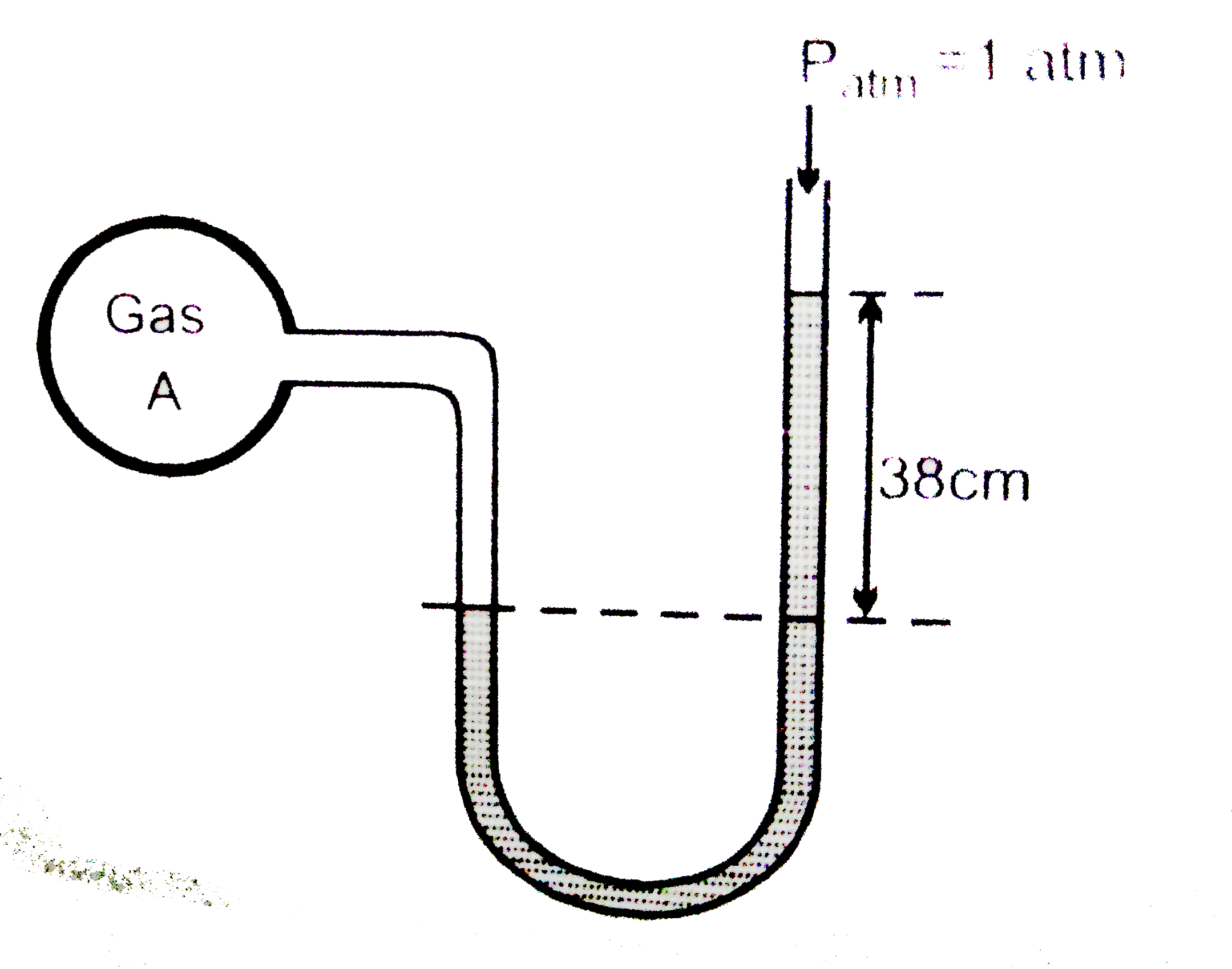A manometer tube contains a liquid of density . When connected to a vessel containing a gas, the liquid level in the other arm of the tube is higher by 20 cm. When connected to another sample of enclosed gas, the liquid level in the other arm of the manometer tube falls 8 cm below the liquid level in the first arm. Which of the two samples exerts more pressure and by what amount ?
To solve the problem, we need to find the pressure exerted by two different gas samples connected to a manometer and determine which one exerts more pressure and by how much.
1. Identify the Given Data:
- Density of the liquid in the manometer, ρ=4×103kg/m3
- Height difference for the first gas sample, h1=20cm=0.2m
- Height difference for the second gas sample, h2=8cm=0.08m
2. Understand the Pressure Relationship:
- The pressure at the gas side of the manometer can be expressed as:
- For the first gas sample:
P1=Pa+ρgh1
- For the second gas sample:
P2=Pa−ρgh2
- Here, Pa is the atmospheric pressure, g is the acceleration due to gravity (approximately 10m/s2), and h1 and h2 are the height differences.
3. Calculate the Pressure Difference:
- To find the difference in pressure between the two gas samples, we subtract the two equations:
P1−P2=(Pa+ρgh1)−(Pa−ρgh2)
- Simplifying this gives:
P1−P2=ρgh1+ρgh2
- This can be factored as:
P1−P2=ρg(h1+h2)
4. Substitute the Values:
- Now, substitute the known values into the equation:
P1−P2=(4×103kg/m3)(10m/s2)(0.2m+0.08m)
- Calculate h1+h2:
h1+h2=0.2+0.08=0.28m
- Now substitute this back:
P1−P2=(4×103)(10)(0.28)
5. Calculate the Final Value:
- Perform the multiplication:
P1−P2=4×103×10×0.28=11200Pa
- Thus, the pressure difference is:
P1−P2=11200Pa or 11.2kPa
6. Conclusion:
- The first gas sample exerts more pressure than the second gas sample by 11200Pa.
- Density of the liquid in the manometer, ρ=4×103kg/m3
- Height difference for the first gas sample, h1=20cm=0.2m
- Height difference for the second gas sample, h2=8cm=0.08m
- The pressure at the gas side of the manometer can be expressed as:
- For the first gas sample:
P1=Pa+ρgh1
- For the second gas sample:
P2=Pa−ρgh2
- Here, Pa is the atmospheric pressure, g is the acceleration due to gravity (approximately 10m/s2), and h1 and h2 are the height differences.
- To find the difference in pressure between the two gas samples, we subtract the two equations:
P1−P2=(Pa+ρgh1)−(Pa−ρgh2)
- Simplifying this gives:
P1−P2=ρgh1+ρgh2
- This can be factored as:
P1−P2=ρg(h1+h2)
- Now, substitute the known values into the equation:
P1−P2=(4×103kg/m3)(10m/s2)(0.2m+0.08m)
- Calculate h1+h2:
h1+h2=0.2+0.08=0.28m
- Now substitute this back:
P1−P2=(4×103)(10)(0.28)
- Perform the multiplication:
P1−P2=4×103×10×0.28=11200Pa
- Thus, the pressure difference is:
P1−P2=11200Pa or 11.2kPa
- The first gas sample exerts more pressure than the second gas sample by 11200Pa.
Topper's Solved these Questions
- FLUID MECHANICSBOOK - DC PANDEY ENGLISHCHAPTER - FLUID MECHANICSEXERCISE - Example 13.11
1 Videos
- FLUID MECHANICSBOOK - DC PANDEY ENGLISHCHAPTER - FLUID MECHANICSEXERCISE - Example 13.12
1 Videos
- FLUID MECHANICSBOOK - DC PANDEY ENGLISHCHAPTER - FLUID MECHANICSEXERCISE - Example 13.9
1 Videos
- EXPERIMENTSBOOK - DC PANDEY ENGLISHCHAPTER - EXPERIMENTSEXERCISE - Subjective
15 Videos
- GENERAL PHYSICSBOOK - DC PANDEY ENGLISHCHAPTER - GENERAL PHYSICSEXERCISE - INTEGER_TYPE
2 Videos
Similar Questions
A manometer tube contains mercury of density 13.6×103 kg m−3. What difference in the levels of mercury in the two arms is indicated by a gauge pressure of 1.03×105Pa?
View SolutionA manometer contains a liquid of density 5.44g/cm3 is attached to a flask containing gas 'A' as follows

If the same liquid is used in barometer to measure the atmospheric pressure, then what will be the lengh of the liquid columnm which exerts pressure equal to 1 atm ? (density of Hg=13.6g/cm3)
View Solution
Knowledge Check
A paramagnetic liquid is taken in a U-tube and arranged so that one of its limbs is kept between pole pieces of the magnet. The liquid level in the limb
Agoes downBrise upCremains sameDfirst goes down and then rise
If a capillary tube is dipped and the liquid levels inside and outside the tube are same. Then the angle of contact is
View SolutionA monometer contains a liquid of density 5.44g/cm3 is attached to a flask containing gas A'asfollows<br><imga≤ocr_imageload∈g=lazysrc=https://d10lpgp6xz60nq.cloudfront.net/physics_images/NRA_PHY_CHM_JMA_C03_E01_213_Q01.pngwh=80%sty≤=background:white;><br>Ifthesameliqusused∈¯ometer→measuretheatmosphericpressure,thenwˆwillbethe≤n>hoftheliquolumn,whichexertspressureequal→1atm?(densityofHg=13.6g//cm^(3))
View SolutionA paramagnetic liquid is taken in a U-tube and arranged so that one of its limbs is kept between pole pieces of the magnet. The liquid level in the limb
View SolutionA gas is filled into a bulb connected to an open limb manometer. The level of mercury in the open arm is 2.1 cm lower than that in the other arm of the manometer. The atmospheric pressure is 740 mm. What is the pressure of the gas?
View SolutionA liquid X of density 3.36g/cm3 poured in a U-tube which contains Hg. Another liquid Y is poured in left arm with heght 8 cm upper levels of X and Y are same. What is density of Y?
View SolutionAn open U-tube contains mercury. When 11.2 cm of water is poured into one of the arms of the tube, how high does the mercury rise in the other arm from its initial level ?
View SolutionA liquid of density 103kgm3 and coefficient of viscosity 8 xx10^(-2) decapoise is flowing in a tube of radius 2 cm with speed 2 m/s. The. Reynold’s number is
View Solution
